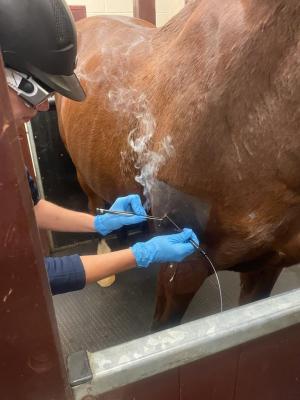Equine Therapy Success Stories: Real People, Actual Psychological Transformations
Equine Therapy Success Stories: Real People, Actual Psychological Transformations
Blog Article
Laser Treatment in Horse Treatment: A Modern Strategy to Improving Equine Health
Laser treatment has actually emerged as a critical strategy in equine therapy, utilizing concentrated light power to cultivate mobile repair work and accelerate recuperation from a variety of conditions. By boosting mitochondrial task and increasing ATP manufacturing, laser treatment not just improves circulation however additionally gives substantial discomfort alleviation.
Comprehending Laser Treatment
Laser therapy, a non-invasive treatment modality, has actually gotten considerable traction in equine medication due to its effectiveness in advertising recovery and discomfort alleviation. Improved ATP degrees quicken tissue repair processes and reduce swelling, making laser therapy particularly reliable for dealing with musculoskeletal injuries, wounds, and other inflammatory problems in equines.
There are several kinds of lasers utilized in equine therapy, each with specific wavelengths and power outcomes customized to various therapeutic demands. Low-level laser therapy (LLLT), also referred to as chilly laser treatment, utilizes reduced power levels to boost cell function without creating thermal damage. High-intensity laser treatment (HILT), on the other hand, uses greater power degrees to accomplish much deeper tissue infiltration and more substantial restorative results.
Veterinarians use numerous laser tools and methods relying on the condition being dealt with and the desired deepness of cells penetration. Correct training and competence are essential for guaranteeing the risk-free and effective application of laser treatment, therefore maximizing its healing potential while lessening risks.
Benefits for Horse Wellness
With a solid understanding of exactly how laser treatment functions, it is very important to discover its countless advantages for equine wellness. Among the key benefits is its ability to accelerate cells repair service and cell development. By boosting mobile feature, laser treatment advertises faster wound healing and aids in the regeneration of broken cells. This can be specifically valuable in reducing recovery times for steeds dealing with injuries.
Additionally, laser therapy has been revealed to boost flow, consequently enhancing blood flow to affected locations. Enhanced blood circulation makes sure that necessary nutrients and oxygen are provided extra successfully, facilitating the recovery process. Additionally, laser treatment's anti-inflammatory impacts help in lowering swelling and pain, which is critical for the general well-being of the steed.
Pain management is an additional significant advantage. By launching endorphins and blocking pain signals, laser therapy provides efficient, non-invasive alleviation from both acute and persistent pain. This can contribute to enhanced movement and quality of life for the pet.
Lastly, laser treatment is a non-invasive treatment alternative, minimizing the threat of problems connected with more intrusive procedures. Its convenience and effectiveness make it an important device in contemporary horse veterinary medicine.
Usual Conditions Dealt With

One more common condition treated with laser therapy is arthritis. Additionally, laser treatment is used in the monitoring of injuries.
Equine respiratory system problems, such as recurrent respiratory tract blockage (RAO), likewise respond favorably to laser treatment. The anti-inflammatory homes of the treatment help in minimizing air passage inflammation, hence boosting breathing function. Laser treatment is useful in treating unguis issues, including laminitis and abscesses. By boosting blood circulation and minimizing pain, it sustains quicker recovery.
Procedure and Safety And Security
Carrying out laser therapy in equine treatment includes a careful procedure to ensure both efficacy and security. Equine Therapy. The process starts with a detailed vet assessment to figure out the viability of laser treatment for the equine's particular problem. As soon as considered ideal, why not check here the treatment area is prepared by cleaning and, if essential, clipping the hair to improve laser penetration
The specialist should choose the proper sort of laser, usually a low-level laser (LLLT) or a high-power laser (HPL), depending upon the problem being dealt with. The laser tool is after that adjusted to the appropriate wavelength, power, and period setups. During the application, the specialist relocates the laser over the targeted location in a systematic way, ensuring constant and even exposure.
Safety methods are strictly adhered to, including making use of protective eyewear for both the specialist and the equine. click here for more Furthermore, it is important to keep track of the horse for any kind of indications of pain or adverse reactions throughout the procedure. Post-treatment, the steed is typically given a period of rest to allow the healing results to show up.

Future of Horse Laser Therapy
As advancements in vet medication proceed to unfold, the future of equine laser therapy holds significant pledge. Emerging innovations and deeper clinical insights are readied to refine and broaden the applications of laser therapy for steeds. One of one of the most expected developments is the assimilation of advanced imaging methods that enable much more precise targeting of damaged tissues, thus boosting healing results. In addition, the growth of mobile and straightforward laser tools is most likely to make this treatment extra available to a more comprehensive variety of practitioners and equine owners.
In addition, ongoing research into the molecular and cellular systems of laser therapy will likely produce optimized procedures customized to specific conditions, improving performance and lowering therapy times. Customized therapy plans based on genetic and biochemical pens could come to be a reality, making sure that each equine gets the most ideal and reliable treatment.
In addition, regulatory developments and standardization of methods will improve the reputation and dependability of laser treatment in equine technique. Equine Therapy. As these developments remain to arise, equine laser treatment is positioned to come to be a crucial element of vet care, offering boosted healing and enhanced lifestyle for equines globally
Conclusion

Report this page